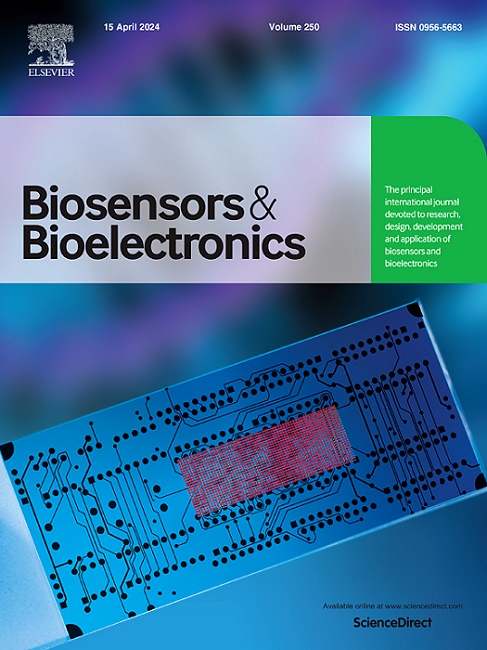基于水凝胶微针的透皮荧光贴片用于阿尔茨海默病的现场无创诊断
IF 10.5
1区 生物学
Q1 BIOPHYSICS
引用次数: 0
摘要
作为一种无创生物传感技术,微针检测间质液(ISF)中的生物标志物受到了广泛关注。然而,很少有研究关注长链非编码rna (lncRNAs)的传感,它们最有可能存在于ISF中,并参与阿尔茨海默病(AD)的发生和发展。本研究以腺癌转录本1 (MALAT1)作为AD患者中异常下调的lncRNAs的代表,将甲基丙烯酸明胶(GelMA)水凝胶MN作为提取工具,结合链位移反应(SDR)介导的荧光探针,开发了一种基于水凝胶MN阵列的MALAT1荧光补片。具体来说,通过简单可行的GelMA光交联制备的MNs,具有良好的提取ISF的膨胀能力和穿透皮肤角质层的机械强度。随后,构建了用于MALAT1传感的三路SDR放大探头。通过与预聚体溶液混合,制备了负载荧光探针的纳米贴片,该贴片在PBS和琼脂糖模拟皮肤中均表现出优异的传感性能,定量下限(LLOQ)分别为7.62 nM和13.24 nM。结果表明,所形成的MN贴片非常适合用于区分AD小鼠ISF中MALAT1表达下调的情况。这项工作是第一个将ISF中MALAT1水平的变化与AD病理联系起来的例子,为AD的早期非侵入性诊断提供了实用工具。本文章由计算机程序翻译,如有差异,请以英文原文为准。
Hydrogel microneedle based transdermal fluorescent patch for the on-site and non-invasive diagnosis of Alzheimer's disease
Detection of biomarkers in interstitial fluid (ISF) by microneedles (MNs) has received extensive attentions as a non-invasive biosensing strategy. However, fewer work has focused on the long non-coding RNAs (lncRNAs) sensing, which are most likely present in ISF and engage in the occurrence and development of Alzheimer's disease (AD). In this work, taking adenocarcinoma transcript 1 (MALAT1) as the representative of lncRNAs, which is abnormally down-regulated in AD patients, a robust hydrogel MN array - based fluorescent patch was developed for MALAT1 by integrating a methacrylated gelatin (GelMA) hydrogel MN as the extraction tool with a strand displacement reaction (SDR) mediated fluorescent probe. Specifically, the MNs were prepared by the simple and feasible photo-crosslinking of GelMA, which displayed satisfactory swelling capability for extracting ISF and mechanical strength to penetrate the skin's cuticle layer. Subsequently, a triplex SDR amplification probe was constructed for MALAT1 sensing. By mixing with the prepolymer solution, the MNs patch loaded with the fluorescent probe was fabricated, which demonstrated excellent sensing performances in both PBS and agarose simulated skin, with lower limits of quantification (LLOQ) of 7.62 and 13.24 nM, respectively. The developed MN patch was proved highly suitable for distinguishing the down-regulated MALAT1 expressions in ISF of AD mice. This work represented the first example to correlate the changes in the levels of MALAT1 in ISF with AD pathology, providing a practical tool for the early non - invasive diagnosis of AD.
求助全文
通过发布文献求助,成功后即可免费获取论文全文。
去求助
来源期刊

Biosensors and Bioelectronics
工程技术-电化学
CiteScore
20.80
自引率
7.10%
发文量
1006
审稿时长
29 days
期刊介绍:
Biosensors & Bioelectronics, along with its open access companion journal Biosensors & Bioelectronics: X, is the leading international publication in the field of biosensors and bioelectronics. It covers research, design, development, and application of biosensors, which are analytical devices incorporating biological materials with physicochemical transducers. These devices, including sensors, DNA chips, electronic noses, and lab-on-a-chip, produce digital signals proportional to specific analytes. Examples include immunosensors and enzyme-based biosensors, applied in various fields such as medicine, environmental monitoring, and food industry. The journal also focuses on molecular and supramolecular structures for enhancing device performance.
 求助内容:
求助内容: 应助结果提醒方式:
应助结果提醒方式:


